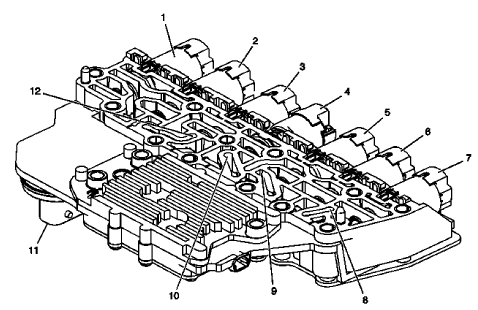Chevrolet Trax: Electronic component description
Control Solenoid Valve Assembly

Fig. 2: View Of Control Solenoid (W/Body & TCM) Valve Assembly
.jpg)
Manual Shift Detent Lever with Shaft Position Switch Assembly
.gif)
Fig. 3: View Of Manual Shift Detent Lever W/ Shaft Position Switch Assembly
The transmission shaft position switch assembly is a sliding contact switch attached to the manual shaft detent lever assembly inside the transmission case. The five inputs to the TCM from the transmission manual shift shaft switch assembly indicate the transmission gear selector lever position. This information is used for engine controls as well as determining the transmission shift patterns. The state of each input is available for display on the scan tool. The five input parameters represented are Signal A, Signal B, Signal C, Signal P (Parity) and Signal N (P/N Start).
Input Speed Sensor (ISS)

Fig. 4: View Of Input Speed Sensor (ISS)
The input speed sensor (ISS) is a hall-effect type sensor. The ISS mounts to the transmission case assembly and connects to the control solenoid (w/body and TCM) valve assembly through a wire harness and connector. The sensor faces the 3-5-R clutch piston housing machined teeth surface. The sensor receives 8.3-9.3 volts on the ISS/OSS Supply Voltage circuit from the TCM. As the 3-5-R/4-5-6 clutch piston housing rotates, the sensor produces a signal frequency based on the machined surface of the 3-5-R/4-5-6 clutch piston housing. This signal is transmitted through the ISS signal circuit to the control solenoid (w/body and TCM) valve assembly.
The TCM uses the ISS signal to determine line pressure, transmission shift patterns, torque converter clutch (TCC) slip speed and gear ratio.
Output Speed Sensor (OSS)
.gif)
Fig. 5: View Of Output Speed Sensor (OSS)
The output speed sensor (OSS) is a hall-effect type sensor. The OSS mounts to the transmission case below the control valve body assembly and connects to the control solenoid (w/body and TCM) valve assembly through a wire harness and connector. The sensor faces the Park gear machined teeth surface. The sensor receives 8.3-9.3 volts on the ISS/OSS supply voltage circuit from the TCM. As the front differential transfer drive gear assembly rotates, the sensor produces a signal frequency based on the machined surface of the Park gear. This signal is transmitted through the OSS signal circuit to the TCM. The TCM uses the OSS signal to determine line pressure, transmission shift patterns, torque converter clutch (TCC) slip speed and gear ratio.
NON-SHIFTING CLUTCH FUNCTION VERIFICATION DESCRIPTION
The 6T30/40/45/50 transmission uses a pressure control system to apply and release clutches during shifts. The transmission control module (TCM) controls pressure commands to the pressure control solenoids.
As normal wear of the transmission clutches occur, the TCM performs a clutch function verification. The TCM momentarily commands a clutch on at a low pressure. The clutch function verification is conducted on smooth roads when the transmission is not shifting and engine torque is consistent and positive.
When a clutch function verification is occurring, a slight bump or drag may be detected momentarily. The clutch function verification will occur a few times over several minutes and will not repeat again for a thousand or more miles. This is a normal condition and no repair attempts should be performed.
The clutch function verification will be performed sooner for a particular clutch if the TCM detects it is producing frequent poor shift control.

